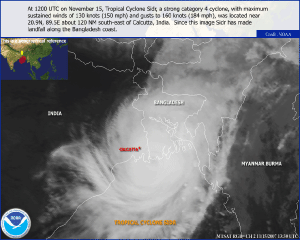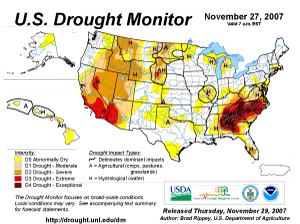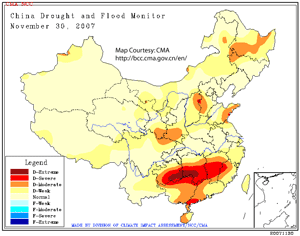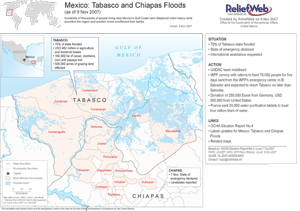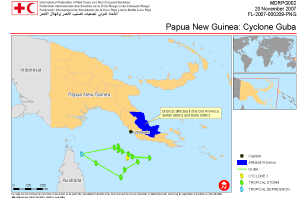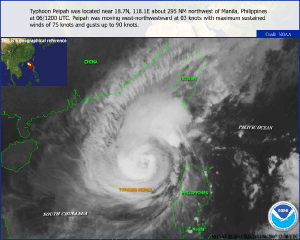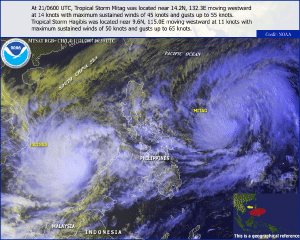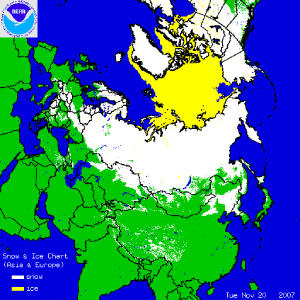
Global Hazards and Significant Events
November 2007
Cyclone Sidr made landfall in Bangladesh on November 15 as an equivalent Category 4 hurricane. Additional information can be found below.

Across the United States, severe to extreme drought conditions continued throughout much of the Southeast region and the western U.S. Exceptional drought persisted in Alabama, Tennessee, Georgia, North and South Carolina. On November 27, 58% of the western U.S., 76% of the Southeast, and 37% of the contiguous U.S. were in moderate to exceptional drought, according to the Federal U.S. Drought Monitor.
For a complete drought analysis across the United States, please see the U.S. drought page.
New wildfires, which began November 24, charred over 1,860 hectares (4,600 acres) of land in southern California. More than 14,000 residents evacuated their homes and more than 50 homes were destroyed (BBC News).
Across China, severe to extreme drought conditions were observed across southeastern Guizhou, northern Guangxi, Hunan, Jiangxi, and western Fujian (Beijing Climate Center).

Heavy rains in Vietnam, which began on October 26 and continued until mid-November, caused widespread flooding that killed as many as 67 people (Associated Press). The floods destroyed more than 15,000 homes and vast area of rice fields and other crops (BBC News).
Torrential rain, which commenced on October 28, caused devastating floods in the state of Tabasco, Mexico. The heavy rain triggered widespread floods, prompted deadly landslides, and caused rivers to flow over their banks, leading to the worst flooding in more than 5 decades (Reuters). Mexico's president, Felipe Calderon, referred to this event as one of the worst natural disasters in Mexico's history (Reuters). Approximately 80% of the state was under water, homes and crops were destroyed, and about half a million people were left homeless (Associated Press). One death was reported (OCHA).
In Papua New Guinea, heavy downpours associated with tropical cyclone Guba caused widespread flooding in the province of Oro, forcing officials to declare a state of emergency. About 500 homes were washed away, 75 people lost their lives and many others were missing. According to reports, floodwaters rose up to 3 meters (11 feet) in some areas, forcing thousands of residents to evacuate. About 70,000 people were affected (BBC News).
In Greece, strong storms produced flooding that inundated roads, houses, and agricultural land, forcing dozens of residents to evacuate the area (BBC News).
Across Malawi, heavy rain fell during November 18-26, causing flash floods that displaced more than 2,000 people. According to reports, about 20 villages were destroyed (Reuters).
During November 21-25, heavy rain fell across the southern Cape of South Africa, prompting flash floods. Thousands of residents were forced to leave their homes and two people lost their lives while doing so (BBC News).
Heavy rain fell during November 24-28, triggering flash floods and landslides in Algeria. According to reports, there were 29 landslides reported and dozens of homes destroyed due to the heavy downpours. Eleven people lost their lives, with many others missing (BBC News).

No reports of significant severe storms were received during November 2007.

Typhoon Peipah developed in the western Pacific Ocean, east of the Philippines, on the 3rd and later that day strengthened to a tropical storm. Peipah made landfall in the northern part of the Philippine Island of Luzon as a Category 1 typhoon on the 6th with maximum sustained winds near 120 km/hr (75 mph or 65 knots) (BBC News). The storm left six people dead while hundreds were rendered homeless (BBC News). Peipah dissipated on the 9th.
Tropical cyclone Sidr developed in the Bay of Bengal on the 9th and intensified to a very severe cyclonic storm, equivalent to a category 4 in the Saffir-Simpson scale, on November 14. Sidr struck Bangladesh on the 15th with maximum sustained winds near 240 km/hr (150 mph or 130 knots), producing heavy rains and high tidal surges that caused widespread flooding (BBC News/Reuters). About 650,000 people were affected and more than 2,400 were killed (Associated Press). Most of the deaths were attributed to falling trees that flattened many homes made of bamboo and tin (AFP). According to reports, Cyclone Sidr is described as the worst storm to strike Bangladesh since 1991 (Reuters/AFP).
Typhoon Hagibis and Mitag developed in the western Pacific Ocean on the 18th and 20th, respectively. Hagibis crossed the Philippines, as a depression but soon after strengthened to a tropical storm. The storm brought heavy rain in the central and southern Philippines triggering floods and landslides. Hagibis, lying over the South China Sea and moving towards Vietnam, intensified to a typhoon with maximum sustained winds of 157 km/hr (98 mph or 85 knots). Although Hagibis did not make landfall in Vietnam, heavy rain associated with the storm fell over south-central Vietnam, prompting the disruption of coffee and oil production (Reuters). Hagibis made a U-turn and headed towards the Philippines once again. According to reports, this is the first time in 10 years a storm has done a U-turn in the country (BBC News). Hagibis downgraded to a depression on the 26th. Meanwhile, Mitag strengthened to a typhoon on the 21st and made landfall in the northern Philippines on the 25th with maximum sustained winds of 157 km/hr (98 mph or 85 knots). The storm was responsible for 8 fatalities and brought heavy rains which flooded at least 50 villages.
For 2006/2007 basin tropical cyclone statistics, please refer to the following:
Australian Basin
North Indian Ocean Basin
Western North Pacific Basin
South Pacific Basin
South Indian Ocean Basin
Northeast Pacific Ocean Basin
Atlantic Basin

Hurricane Noel, which developed in October, reached Category 1 hurricane strength on November 1, but by the 2nd transitioned to a strong extratropical storm. On November 4, Noel struck the Canadian Maritimes with maximum sustained winds near 135 km/hr (84 mph or 73 knots). The storm produced heavy rain and left about 100,000 people without power (Canadian press/BBC News)

Across much of Europe, an early winter season has prompted many ski resorts to open early this year. Since the week of November 11, snow fell continuously across parts of Europe. According to reports, Austria experienced its earliest arrival of severe winter weather in decades with up to 508 mm (20 inches) of snow falling in Vienna on the 15th. Meanwhile, Switzerland had 635-711 mm (25-28 inches) of snow fall, with Zurich having its heaviest snow fall since 1955. This is the first time in over 5 decades Switzerland has seen such a strong start to its winter ski season (BBC News).
 NOAA's National Centers for Environmental Information
NOAA's National Centers for Environmental Information
